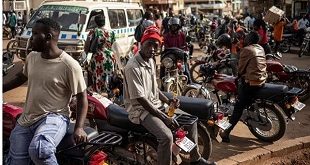
By Rukiya Makuma & Dicta Asiimwe
Bad habits, poverty, and bureaucracy have turned Kampala into the pothole capital of the world
There was a time when it was fun driving down Rotary Avenue or Lugogo Bypass as it is commonly known. As a dual carriage, with minimal traffic and few bends, it was perfect for cruising at least until one neared the roundabout at Kira Road Police station. But the fun is over. Huge mounds of earth stretch across the road on both sides at the junction of Rotary Avenue and Mackenzie Vale Road.
It all started with a tiny pothole barely felt if you hit it at speeds of 120km per hour. Then it grew until even the four-by-fours had to slow down. Then foul smelling storm and sewerage water started to sit on the disappearing tarmac, flying up the car window as you drove passed. Finally, came the earth mounds and the usual sign: Slow men at work
Who needs slow men working, one motorist complained, Cant these men work faster?
Anxiety over the road repair is mounting. Motorists who previously cruised quickly between Bukoto and Nakawa are angry to be delayed by snarled traffic. So how did a tiny pothole grow into this mess at Mackenzie Vale?

The Kampala City Council spokesperson Simon Rugadya Muhumuza says the problem is not the pothole that motorists see and complain about but the drainage system for the roads.
“All those problems you have called potholes like the one on Bukoto Road in Kamwokya are actually drainage problems,†Muhumuza said.
The Minister of State for Works and Transport, John Byabagambi, agrees. He says most people complain about a poor road network but do not know that a good drainage system ensures long lasting roads.
“A road cannot last ten percent of its estimated lifespan if it has no proper drainage system,†Byabagambi says.
He says one of the biggest causes of poor roads in Kampala is putting tarmac on roads with no proper drainage systems. He says storm water is not supposed to run on the road but drain away immediately after rain otherwise erodes the tarmac. The drainage system is supposed to be part of road constructed but either the contractors do not put the drainage or it is so poor it stops working after a very short time.
But after agreeing on the causes, KCC and the central government trade blame over why the problem is not addressed.
Most city residents would dance for joy if they only had the Mackenzie Vale pothole to deal with daily. Instead potholes stare at you everywhere as if welcoming you to the city. They come in all shapes and cover most city roads. Some really big ones look like crater lakes when it rains. They have generated a lot of debate and many people want Kampala City Council and the government to rid city roads of the potholes but so far, nothing effective has been done.

Occasionally, the roads are dug up around the damaged spot and the holes are filled with either earth or bitumen. But the roads smoothness does not last the patches are washed away by the first rains and even bigger potholes result.
I no longer use the Bugolobi route because of the huge potholes, says John Ddumba a taxi driver who used to ply this route. He says he now operates in other areas whose roads are not as bad. When I plied the Bugolobi route I used to spend more time in the garage than on the zig zag road because of the damage caused by these potholes on my taxi, he adds.
Potholes are a nuisance to all drivers. They bog down traffic, cause accidents, and damage motor vehicles. Falling into and crawling out potholes ruins the suspension system, bodywork and general running of most motor vehicles. They can cause premature damage to steering components, tyres, rims and the lower engine. Undercarriage components such as the exhaust system can be compromised in the long run. Repairing the vehicles costs money and time.
We pay a lot of taxes but where does all this money end? asks Musa Sekkajja, a motor cycle driver on Luwuum Street, The roads are filthy and a shame to our country. He says attempts at repairing the roads worsen the situation because whichever contractor is hired digs up the road and that part of the road will remain inaccessible for months without completion.

Ester Adera, a pedestrian, suggests that Kampala City Council (KCC), which is responsible for the maintenance of city roads, hands over the role to the ministry of Works.
However, KCC blames the poor drainage system and potholes in Kampala on the central government.
The central government gives KCC Shs 15 billion per year but on condition that it is used to fix potholes and not the drainage.
Minister Byabagambi disagrees. He says the government does not insist that KCC not use central government money to fix road drainage but accused KCC of not spending its own money on roads.
 “Government started giving money to KCC in the 2007/2008 financial year, where did they put the revenue they were using before then?†Byabagambi asks. He says that the government’s contribution was meant to be a top up. He says KCC was collecting enough money to maintain roads. The new money should have gone to fixing the drainage.Muhumuza however explained that the problem of drainage was too big for KCC to handle. He says storm water gathers silt and causes blockage when it deposits it in the drainage systems. Poor disposal of litter, especially Buveera (plastics) adds to the problems since just one Kaveera can block an otherwise open and big enough drainage system. He added that drainage systems especially the open ones have become dumping areas for waste. He says KCC needs up to Shs 1.5 billion annually to maintain the drainage systems but only gets Shs 400 million.
Expiry of the design life of the roads, poor drainage because most of Kampala is built on swampy areas, heavy traffic, heavy weight vehicles and failure by the government to provide more money compound KCC’s woes.
Muhumuza says that the “Misconception people have is that Kampala roads are a responsibility of KCC alone and yet the roads are used by the entire countryâ€. He says the population of Kampala during the day is estimated at 2.5 million and this means each person contributes a paltry Shs 12,000 per year as tax to do roads, hospitals, and schools. On a monthly basis each person contributes Shs 1,000 as tax. “With this, people expect the roads to be perfect; expect to find drugs in hospitals,†he says. He says if people were more realistic and contributed Shs 10,000 as tax monthly, it would raise KCC’s budget and enable it to do more. He says KCC gets the same amount of money as districts and yet it has more demands. Uganda has about 500,000 registered motor vehicles. Over 60 percent (300,000) drive on Kampala roads. Kampala, which is only 195 square kilometers, bears 60 percent of the national volume of traffic.
“A road is like a cloth which wears and tears,†he says, “The roads in the city were constructed in the 1950s and usually roads have a lifespan of 15 years plus maintenance though some are made to last for three to seven years. This means the roads we have should have been reconstructed like over four times which has not been the case.â€
Muhumuza says the average cost of constructing one kilometer of road at the current price is Shs 1 billion and that means KCC needs Shs 1 trillion to upgrade the roads in the city to the desired tarmac standards. That is equivalent to 15 years worth of KCC’s annual road budget. Kampala has 1,100 kilometers of road network and of these the ministry of Works is responsible for 40 percent.Â
The drainage plan for Kampala shows that the city has eight drainage systems but only one was upgraded. The drainage systems are Nakivubo, Lubigi, Nalukolongo, Kansanga, Mayanja-Kaliddubi, Nalubaga and Walufumbe drainage systems. Muhumuza said KCC would need $ 78.95 million (Shs 176.8 billion) as capital costs to solve Kampala’s drainage problems. KCC does not have that money.
Fortunately, Muhumuza says, the central government is beginning to realise that the money it has been providing is “peanutsâ€. On Apr. 14, the Works and Transport Minister John Nasasira, announced that Kampala city potholes and traffic jams will be history by 2014. Nasasira believes he has two magic bullets; the Greater Kampala Metropolitan Area (GKMA) Master plan and Metropolitan Area Transport Authority (MATA).
The US$198 million World Bank funded GKMA project is to improve the connectivity and efficiency of the transport and road management in Kampala. It involves creation of Metropolitan Area Transport Authority (MATA) and a US$4.5 million Kampala Urban Transport Project funded by the International Development Agency. Both projects are already late and the earth mounds at Mackenzie Vale and potholes all over the city continue to expand.
 The Independent Uganda: You get the Truth we Pay the Price
The Independent Uganda: You get the Truth we Pay the Price



